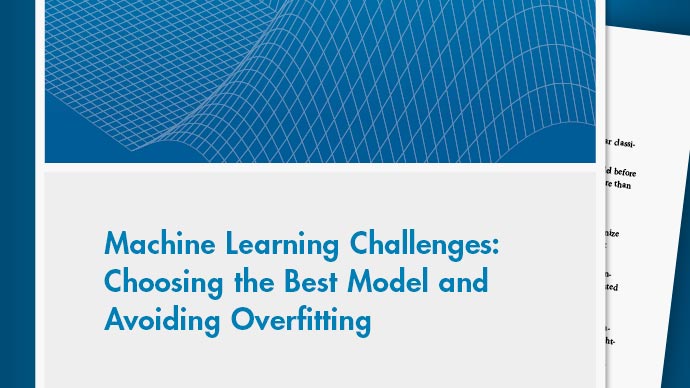Evaluate a Surface Fit
This example shows how to work with a surface fit.
Load Data and Fit a Polynomial Surface
loadfranke; surffit = fit([x,y],z,'poly23','normalize','on')
Linear model Poly23: surffit(x,y) = p00 + p10*x + p01*y + p20*x^2 + p11*x*y + p02*y^2 + p21*x^2*y + p12*x*y^2 + p03*y^3 where x is normalized by mean 1982 and std 868.6 and where y is normalized by mean 0.4972 and std 0.2897 Coefficients (with 95% confidence bounds): p00 = 0.4253 (0.3928, 0.4578) p10 = -0.106 (-0.1322, -0.07974) p01 = -0.4299 (-0.4775, -0.3822) p20 = 0.02104 (0.001457, 0.04062) p11 = 0.07153 (0.05409, 0.08898) p02 = -0.03084 (-0.05039, -0.01129) p21 = 0.02091 (0.001372, 0.04044) p12 = -0.0321 (-0.05164, -0.01255) p03 = 0.1216 (0.09929, 0.1439)
The output displays the fitted model equation, the fitted coefficients, and the confidence bounds for the fitted coefficients.
Plot the Fit, Data, Residuals, and Prediction Bounds
plot(surffit,[x,y],z)

Plot the residuals fit.
plot(surffit,[x,y],z,'Style','Residuals')

Plot prediction bounds on the fit.
plot(surffit,[x,y],z,'Style','predfunc')

Evaluate the Fit at a Specified Point
Evaluate the fit at a specific point by specifying a value forxandy, using this form:z = fittedmodel(x,y).
surffit(1000,0.5)
ans = 0.5673
Evaluate the Fit Values at Many Points
xi = [500;1000;1200]; yi = [0.7;0.6;0.5]; surffit(xi,yi)
ans =3×10.3771 0.4064 0.5331
Get prediction bounds on those values.
[ci, zi] = predint(surffit,[xi,yi])
ci =3×20.0713 0.6829 0.1058 0.7069 0.2333 0.8330
zi =3×10.3771 0.4064 0.5331
得到模型方程
Enter the fit name to display the model equation, fitted coefficients, and confidence bounds for the fitted coefficients.
surffit
Linear model Poly23: surffit(x,y) = p00 + p10*x + p01*y + p20*x^2 + p11*x*y + p02*y^2 + p21*x^2*y + p12*x*y^2 + p03*y^3 where x is normalized by mean 1982 and std 868.6 and where y is normalized by mean 0.4972 and std 0.2897 Coefficients (with 95% confidence bounds): p00 = 0.4253 (0.3928, 0.4578) p10 = -0.106 (-0.1322, -0.07974) p01 = -0.4299 (-0.4775, -0.3822) p20 = 0.02104 (0.001457, 0.04062) p11 = 0.07153 (0.05409, 0.08898) p02 = -0.03084 (-0.05039, -0.01129) p21 = 0.02091 (0.001372, 0.04044) p12 = -0.0321 (-0.05164, -0.01255) p03 = 0.1216 (0.09929, 0.1439)
To get only the model equation, useformula.
formula(surffit)
ans = 'p00 + p10*x + p01*y + p20*x^2 + p11*x*y + p02*y^2 + p21*x^2*y + p12*x*y^2 + p03*y^3'
Get Coefficient Names and Values
Specify a coefficient by name.
p00 = surffit.p00
p00 = 0.4253
p03 = surffit.p03
p03 = 0.1216
Get all the coefficient names. Look at the fit equation (for example,f(x,y) = p00 + p10*x...) to see the model terms for each coefficient.
coeffnames(surffit)
ans =9x1 cell{'p00'} {'p10'} {'p01'} {'p20'} {'p11'} {'p02'} {'p21'} {'p12'} {'p03'}
Get all the coefficient values.
coeffvalues(surffit)
ans =1×90.4253 -0.1060 -0.4299 0.0210 0.0715 -0.0308 0.0209 -0.0321 0.1216
Get Confidence Bounds on the Coefficients
用信心界限系数来帮助你evaluate and compare fits. The confidence bounds on the coefficients determine their accuracy. Bounds that are far apart indicate uncertainty. If the bounds cross zero for linear coefficients, this means you cannot be sure that these coefficients differ from zero. If some model terms have coefficients of zero, then they are not helping with the fit.
confint(surffit)
ans =2×90.3928 -0.1322 -0.4775 0.0015 0.0541 -0.0504 0.0014 -0.0516 0.0993 0.4578 -0.0797 -0.3822 0.0406 0.0890 -0.0113 0.0404 -0.0126 0.1439
Find Methods
List every method that you can use with the fit.
methods(surffit)
Methods for class sfit: argnames dependnames indepnames predint sfit category differentiate islinear probnames type coeffnames feval numargs probvalues coeffvalues fitoptions numcoeffs quad2d confint formula plot setoptions
Use thehelp命令to find out how to use a fit method.
helpsfit/quad2d
QUAD2D Numerically integrate a surface fit object. Q = QUAD2D(FO, A, B, C, D) approximates the integral of the surface fit object FO over the planar region A <= x <= B and C(x) <= y <= D(x). C and D may each be a scalar, a function handle or a curve fit (CFIT) object. [Q,ERRBND] = QUAD2D(...) also returns an approximate upper bound on the absolute error, ERRBND. [Q,ERRBND] = QUAD2D(FUN,A,B,C,D,PARAM1,VAL1,PARAM2,VAL2,...) performs the integration with specified values of optional parameters. See QUAD2D for details of the upper bound and the optional parameters. See also: QUAD2D, FIT, SFIT, CFIT.

